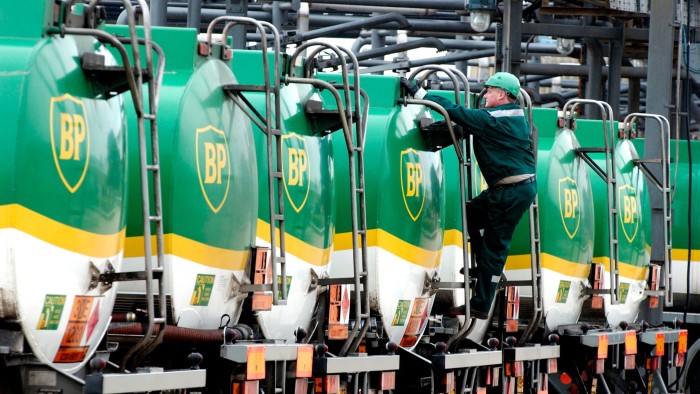Live teaching case: BP’s decision to adjust its climate change targets

Roula Khalaf, Editor of the FT, selects her favourite stories in this weekly newsletter.
In 2020, the British energy group BP pledged to decarbonise its portfolio, cutting oil and gas production by 40 per cent from 2019 levels by 2030 and channelling billions of dollars into wind and solar projects.
Then, in February 2023, the company stunned observers by retreating from these lofty goals — promising shareholders it would invest heavily into oil and gas projects and recalibrating its oil and gas reduction goal from 40 per cent to 25 per cent by the end of the decade.
This decision will increase investment in the production of fossil fuels for the rest of the decade by about $1bn per year, beyond previous plans. And it was announced shortly after the company — in line with its competitors — reported record annual profits: $27.7bn for 2022, almost double the adjusted profit of 2021.
Scientists say the world needs to cut greenhouse gas emissions by about 45 per cent by 2030. This is in order to have any hope of meeting the climate change targets in the 2015 Paris Agreement: to keep global average temperatures to no more than 1.5-2°C above pre-industrial levels.
FT Online MBA ranking 2022 — 10 of the best

Find out which schools are in our ranking of Online MBA degrees. Learn how the table was compiled and read the rest of our coverage at ft.com/online-learning.
That will require the reduction, or even elimination, of emissions from fossil fuels.
What does BP’s renewed emphasis on oil and gas imply for the private sector’s ability to transition to more sustainable fuels voluntarily?
Read these two FT articles, explore the background, and discuss the questions that follow:
BP slows oil and gas retreat after record $28bn profit
What Big Oil’s bumper profits mean for the energy transition
Background
BP (formerly British Petroleum) has long staked a claim as one of the leaders of the fossil fuel industry in tackling climate change. In March 2002, its CEO declared in a speech at Stanford that BP would now mean “Beyond Petroleum.” Yet its journey has been fraught. In 2006, a damaged BP pipeline caused one of the largest oil spills in Alaska’s history and, in 2010, it was behind the Deepwater Horizon disaster, unleashing the largest oil spill in history. BP quietly shed its “Beyond Petroleum” branding and many of its renewable assets.
In 2020, the company recommitted to decarbonisation goals, adopting aggressive targets for 2030. It appeared that “Beyond Petroleum” was back. But oil and gas prices surged in the wake of the Ukraine war. Brent crude, the international oil benchmark, averaged $101 per barrel in 2022, more than double its price in 2020. Natural gas prices also soared, largely because Russia cut off supplies to Europe.
BPs chief executive Bernard Looney defended its latest reversal, stating that “The conversation three or four years ago was somewhat singular around cleaner energy, lower-carbon energy. Today, there is much more conversation about energy security, energy affordability.” In another interview, he added: “We have to invest in today’s energy system, and the reality is that today’s energy system is predominantly an oil and gas system. And that needs investment.”
Anja-Isabel Dotzenrath, BP’s executive vice-president for gas and low-carbon energy, said the increased capital expenditure demonstrated the group’s continued commitment to rolling out 50 gigawatts of renewable power by 2030. She said BP will maintain a long-term ambition to reach net zero emissions by 2050, and to use 50 per cent of investment on low-carbon businesses by 2030 — an amount similar to that of oil and gas. But the company will adopt a sharper focus on businesses closer to BP’s strengths, like charging points for electric vehicles, cleaner fuels derived from plants, and biofuels from landfill.
BP is not alone in its objectives of reducing carbon emissions. Other large fossil-fuel companies have made similar pledges. But critics remain sceptical because these pledges are not binding and do not include complete and absolute reductions of scope 3 emissions (those emitted when oil, gasoline and diesel oil are burnt, which comprise up to 90 per cent of an oil company’s carbon footprint).
These companies’ “net zero” policies do not mean they will no longer produce and sell fossil fuels. Instead, they plan to rely on either offsetting schemes, like tree planting, or carbon capture and sequestration technologies, which are not yet market ready, in the hope of reducing or eliminating net emissions.
To some critics, the objective for any fossil-fuel company to achieve actual net zero, including downstream scope 3 emissions for those in its supply chain, is an existential threat, especially if it is to be achieved in time to meet the Paris Agreement targets.
How do we make sense of these developments? Here are some questions to choose from for guiding discussion.
Why do you think BP made the decision to pull back on decarbonisation?
i) Does it represent a lack of sincerity on the part of BP in making its earlier targets?
ii) Does it represent a lack of foresight in making its earlier targets? The stated need in 2023 to focus on today’s energy system of oil and gas was also true in 2020 when Looney decided instead to shrink the company’s fossil fuel footprint dramatically. Was the company unprepared for the sharp rise in oil prices? If so, what should we think of its revised projections for economic growth through fossil-fuel production?
iii) Is the pressure from shareholders just too much to maintain any kind of serious carbon reduction goals? The valuation of companies like BP and Shell, which have embraced climate-friendly investments in renewable energy, have substantially lagged behind those of their American rivals ExxonMobil and Chevron, which have largely stuck to producing oil and gas.
iv) Is BP focusing on the wrong shareholders? Some investors loved the February strategy shift. BP shares surged more than 7.5 per cent, the largest one-day jump in more than two years, and hit their highest mark in almost four years three days later, gaining around 17 per cent. Others were not pleased. Half of BP’s top ten institutional shareholders are members of Climate Action 100+, a large group of institutional investors focused on climate action and responsible for more than $68tn in assets under management. The group supported BP’s earlier climate commitments just nine months ago and are voicing concerns over BPs pivot.
v) Do recent financial challenges for the company require a reassessment of its climate commitments? The war in Ukraine might be seen as a “black swan” event for global energy markets. As a result of the war, BP exited its 19.75 per cent stake in Rosneft (roughly $14bn), the oil company controlled by the Russian government, in February 2022. This write-off followed the disastrous Gulf of Mexico Deepwater Horizon oil spill in 2010 which, by some estimates, cost BP and its partners $71bn over 10 years.
What were the viable alternatives, and what might have pointed BP in another direction?
What does BP’s decision say about the ability of shareholder owned for-profit companies to steer towards decarbonisation?
What does BP’s decision say about our ability as a global society to wean ourselves off fossil fuels and address the climate change challenge?
Optional extra background reading (note the reader comments):
BP: Looney leans in to a longer runoff for oil
Why BP’s Bernard Looney changed his tune
Big Oil’s big profits need to be spent wisely
BP’s shift leaves a bigger question on credibility than climate
BP defends transition strategy after curbing retreat from oil and gas
BP: No longer ‘Beyond Petroleum’. Again.
Andrew Hoffman and Jerry Davis are professors at University of Michigan Ross School of Business
Climate Capital

Where climate change meets business, markets and politics. Explore the FT’s coverage here.
Are you curious about the FT’s environmental sustainability commitments? Find out more about our science-based targets here
Comments